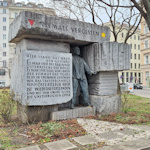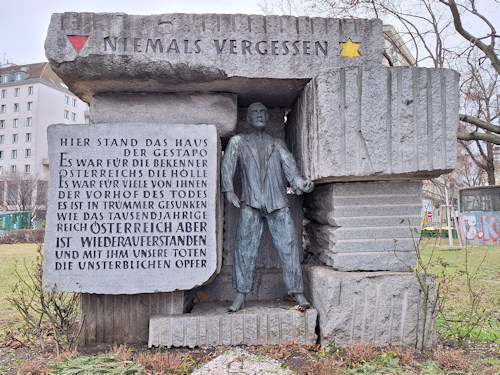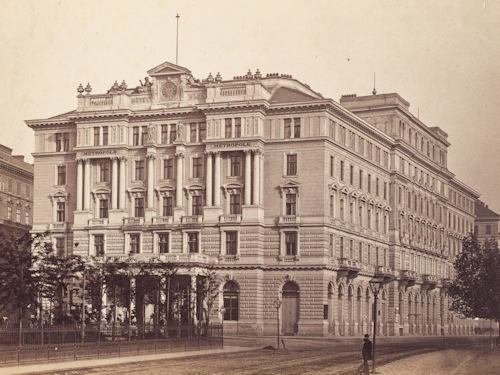
Morzinplatz seems to lack the typical urban beauty of a central Vienna square. Once home to the Gestapo, perhaps too much ugly history hangs in the air. A redeeming feature, though, is the memorial honouring the victims of the Nazi regime.
- Granite and bronze monument from 1985
- Located next to the site of the Gestapo HQ
- Take a guided WWII walking tour* of Vienna
- See also:
Dark times…

(Niemals vergessen: “never forget”)
Stand on Morzinplatz square on a bright summer day, and you might spot tourists waving from a riverboat on the Donaukanal river channel.
Or look up the road to see people pouring out of Schwedenplatz subway station, perhaps in search of ice cream or heading up to the bars that fill this area.
The view had a more sinister ambience back in WWII, as a memorial on the square’s north corner highlights.
The bronze and granite installation bears the inscription Niemals Vergessen (“never forget”). Designed by Leopold Grausam, it honours the victims of national socialism (particularly the Gestapo) during the period of Nazi rule in Austria.
Why here?

(The Leopold-Figl-Hof building with the Morzinplatz memorial in front of it)
Well, opposite the memorial you find an apartment building constructed in the 1960s and named after Leopold Figl (1902-1965), a former Austrian chancellor and foreign minister.
Figl and the occupying WWII allies famously signed the Staatsvertrag in the marble hall of Upper Belvedere palace in 1955; the document granted Austria its post-war independence.
The Leopold-Figl-Hof occupies the site of the former Hotel Metropole, a luxury Neorenaissance establishment built in the late 1800s (Mark Twain once stayed there) and reduced to a ruin toward the end of WWII.
This is where the Nazi connection comes in: the Gestapo confiscated (i.e. stole) the Jewish-owned hotel in 1938 and set up their headquarters inside. A place to administer a regime of terror and oppression.

(Hotel Metropole around 1880, as published by the Michael Frankenstein & Comp. photo studio; Wien Museum Inv.-Nr. 78079/569/1; excerpt reproduced with permission under the terms of the CC0 licence)
Vast numbers of people were interrogated and tortured on site and then sent off to die in concentration camps: socialists, communists and other political opponents; Jews; homosexuals; Jehovah Witnesses etc. etc.
Leopold Figl himself survived imprisonment in Dachau and other camps as a political prisoner, giving added resonance to the choice of name for the building that replaced the Gestapo HQ.
A relief along the Hof’s front, flanked by the dates 1938 and 1945 in Roman numerals, honours those who suffered on that site. The rear of the building also has memorial rooms for the victims of the Vienna Gestapo.
Somewhat oddly, plaques to the immediate sides only note that the Hof was erected on the site of a “Wohnhaus” (residence) destroyed in the war years.
The history of the associated memorial reflects the difficulties of Austria’s post-war process of self-reflection.
A first version went up on Morzinplatz in 1951 (initially without permission), placed there out of frustration at the delay in recognising the political victims of the Nazis with a suitable installation.
The current version replaced that original in 1985 but retained the inscription that now fills one half of the front (my rough translation):
Here once stood the Gestapo building. It was hell for those who took a stand for Austria. For many of them it proved death’s antechamber. It fell into ruin, just like the 1,000-year Reich. Austria, though, rose from the grave and with her our dead, the immortal victims.

(The dining room of Hotel Métropole sometime after 1873 in a photo published by Leopold Theodor Neumann; Wien Museum Inv.-Nr. 106081/45; excerpt reproduced with permission under the terms of the CC0 licence)
Two coloured symbols sit either side of the memorial’s top. Political prisoners wore the inverted red triangle symbol in the concentration camps; Jews were forced to wear the yellow star (also in public).
The absence of other symbols used in those camps (such as the inverted pink triangle worn to identify, for example, homosexuals) has led to criticism and protest actions.
Indeed, one such action can be seen in permanent form as a stone block behind the memorial. The block’s inscription says:
We have done what they didn’t do
Should you wish to see other memorials and locations related to WWII and the period of Nazi rule, then I have a whole article for you with tips and suggestions.
How to get to Morzinplatz
The square lies at the edge of the old town and close to popular subway and tram lines. Although central, it has few places of note immediately nearby. Though the Ruprechtskirche rises above its western edge: a church whose history goes back over 1000 years.
Subway: take the U1 or U4 line to Schwedenplatz and walk along Franz-Josefs-Kai.
Tram: take line 1 to Salztorbrücke. The 1 encircles most of the old town.
The square also has a direct bus connection to and from the airport.
Address: Morzinplatz, 1010 Vienna